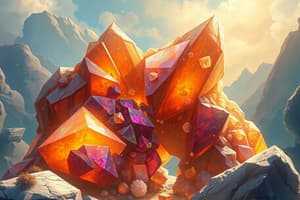Podcast
Questions and Answers
Which of the following is a physical property used to identify minerals?
Which of the following is a physical property used to identify minerals?
- Weight
- Density
- Volume
- Color (correct)
Where are protons located within an atom?
Where are protons located within an atom?
- In the electron cloud
- In the neutron
- In the nucleus (correct)
- Outside the nucleus
Which mineral is commonly used for sandpaper and jewelry?
Which mineral is commonly used for sandpaper and jewelry?
- Graphite
- Garnet (correct)
- Sulfur
- Diamond
What accounts for the difference in hardness between diamond and graphite?
What accounts for the difference in hardness between diamond and graphite?
Which mineral group is made of minerals containing only one element?
Which mineral group is made of minerals containing only one element?
Match the physical property with its use in identifying minerals:
Match the physical property with its use in identifying minerals:
Match the mineral with its primary use:
Match the mineral with its primary use:
Match the subatomic particle with its location and charge:
Match the subatomic particle with its location and charge:
Match the mineral group with its composition:
Match the mineral group with its composition:
Match the definition with the term:
Match the definition with the term:
Flashcards are hidden until you start studying
Study Notes
Physical Properties of Minerals
- Streak, luster, color, cleavage, fracture, and hardness are physical properties used to identify minerals.
Atomic Structure
- Protons are located in the nucleus of an atom.
Mineral Properties and Uses
- Corundum is a mineral commonly used for sandpaper and jewelry.
Diamond and Graphite
- The difference in hardness between diamond and graphite is due to the different arrangements of carbon atoms.
Mineral Groups
- Native elements are a mineral group made up of minerals containing only one element.
Physical Properties and Mineral Identification
- Streak can be used to identify the mineral composition.
- Luster can be used to identify the mineral's appearance.
- Color can be used to identify the mineral's visible appearance.
- Cleavage can be used to identify the mineral's breaking pattern.
- Fracture can be used to identify the mineral's breaking pattern when it does not cleave.
- Hardness can be used to identify the mineral's resistance to scratching.
Mineral Uses
- Corundum is primarily used for sandpaper and jewelry.
- Diamond is primarily used for drilling and cutting tools.
Subatomic Particles
- Protons are positively charged and located in the nucleus.
- Neutrons are neutral and located in the nucleus.
- Electrons are negatively charged and located in the electron cloud.
Mineral Groups and Composition
- Native elements are composed of minerals containing only one element.
- Oxides are composed of minerals containing oxygen and one or more other elements.
- Silicates are composed of minerals containing silicon and oxygen, along with other elements.
Studying That Suits You
Use AI to generate personalized quizzes and flashcards to suit your learning preferences.




